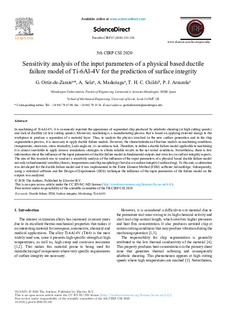Title
Sensitivity analysis of the input parameters of a physical based ductile failure model of Ti-6Al-4V for the prediction of surface integrityAuthor (from another institution)
Publication Date
2020Other institutions
University of LeedsVersion
Published versionDocument type
Journal ArticleJournal ArticleLanguage
EnglishRights
© 2020 The AuthorsAccess
Open accessPublisher’s version
https://doi.org/10.1016/j.procir.2020.02.105Published at
Procedia CIRP. Vol. 87. Pp. 533-538, 2020Publisher
Elsevier LtdKeywords
ductile failure
FEM
Surface integrity
Machining ... [+]
FEM
Surface integrity
Machining ... [+]
ductile failure
FEM
Surface integrity
Machining
Ti-6Al-4V [-]
FEM
Surface integrity
Machining
Ti-6Al-4V [-]
Abstract
In machining of Ti-6Al-4V, it is commonly reported the appearance of segmented chip produced by adiabatic shearing (at high cutting speeds) and lack of ductility (at low cutting speeds). Moreover, mac ... [+]
In machining of Ti-6Al-4V, it is commonly reported the appearance of segmented chip produced by adiabatic shearing (at high cutting speeds) and lack of ductility (at low cutting speeds). Moreover, machining is a manufacturing process that is based on applying external energy to the workpiece to produce a separation of a material layer. Thus, to analyze the physics involved in the new surface generation and in the chip segmentation process, it is necessary to apply ductile failure models. However, the characterization of fracture models in machining conditions (temperature, strain rate, stress triaxiality, Lode angle etc.) is an arduous task. Therefore, to define a ductile failure model applicable to machining it is almost inevitable to apply inverse simulations strategies to obtain reliable results in the not tested conditions. Nevertheless, there is few information about the influence of the input parameters of ductile failure model in fundamental outputs and even less in surface integrity aspects. The aim of this research was to conduct a sensitivity analysis of the influence of the input parameters of a physical based ductile failure model not only in fundamental variables (forces, temperatures and chip morphology) but also on surface integrity (surface drag). To this end, a subroutine was developed for the ductile failure model and it was implemented in the Finite Element Method (FEM) software AdvantEdge. Subsequently, using a statistical software and the Design of Experiments (DOE) technique the influence of the input parameters of the failure model on the outputs was analyzed. [-]
xmlui.dri2xhtml.METS-1.0.item-sponsorship
Gobierno Vasco-Eusko Jaurlaritzaxmlui.dri2xhtml.METS-1.0.item-projectID
info:eu-repo/grantAgreement/GV/Convocatoria de ayudas a la Investigación básica y-o aplicada 2018-2020/PIBA 2018-85/CAPV/Desarrollo de banco de ensayos de mecanizado lineal de alta velocidad para análisis de la condición de integridad superficial de aleaciones aeronáuticas y validación de modelos predictivos del proceso de corte/MECAEROCollections
- Articles - Engineering [758]
The following license files are associated with this item:






















